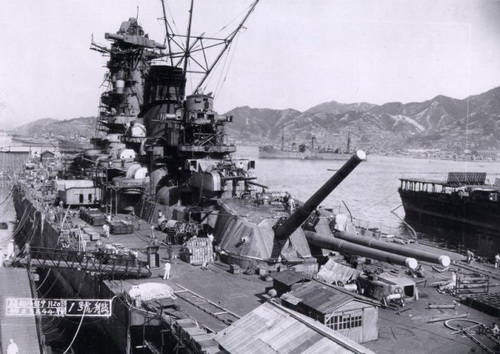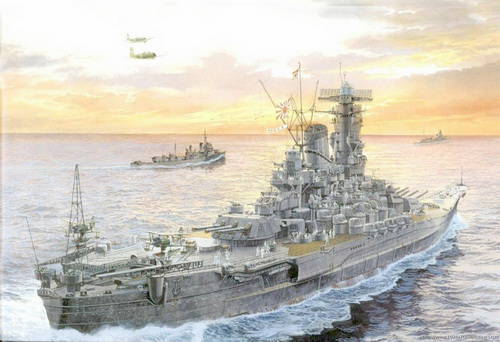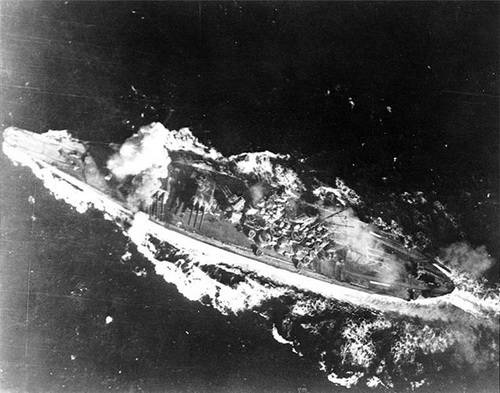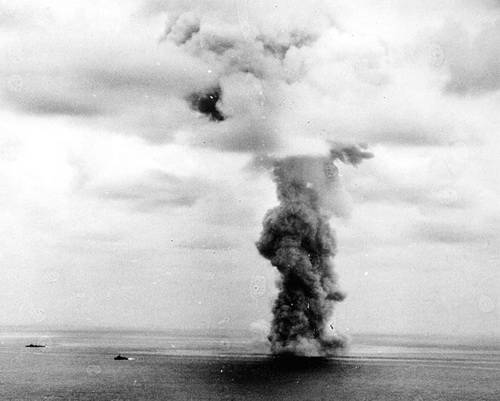The death of the battleship Yamato
The Yamato and Musashi were the largest artillery ships in the world, capable of hitting targets at any distance from the Mars. The recoil of artillery guns was so strong that the designers had to impose a ban on the use of an onboard salvo — a simultaneous shot from all 9 barrels — in order to avoid mechanical damage to the ship that was irreversible.
Reservations were made according to the “all or nothing” scheme and included an 410-mm inclined belt and the world's thickest deck (200-230 mm.), Even the bottom of the vessel was protected by 50-80-mm. armored plates. This concept involved the creation of an armored stronghold that would protect all the vital centers of the vessel, providing it with a reserve of buoyancy, while leaving everything else unprotected. The Yamato Citadel was the shortest among the battleships built at the end of the 30-s with respect to the total length of the ship — the entire 53,5%. The front plate of the towers of the main caliber of the battleship had armor in 650-mm - the thickest armor ever installed on warships. The strong inclination of the frontal slab of the turret further increased the resistance of the projectile; it was believed that not a single projectile in the world was able to pierce it even when fired at close range.

Japanese shipbuilders should pay tribute, they did almost everything that was in their power. The final word remained with the admirals, and here the descendants of samurai and students of the famous Togo suddenly showed up problems. At the very beginning of the war, the officers and pilots of the Japanese aircraft carriers joked bitterly that there are 3, the biggest and most useless things in the world: the Egyptian pyramids, the Great Wall of China and the battleship Yamato. The Japanese fleet often lacked its own battleships, which the fleet command protected. Using them at the very end of the war could not in any way change its outcome, the joke turned out to be very truthful.
The last trip "Yamato"
The battleship "Yamato" went on his last trip in April 1945. The task of the connection, which, in addition to the battleship, included the cruiser "Yahagi" and 8 destroyers, among which were 2 special air defense destroyers of the "Akizuki" type (at that time there were other combat-ready ships, but there was no fuel for them), it was on a fine line between a combat operation and suicide. The squadron was supposed to repel all attacks of the American aviation and reach the landing site of American units on about. Okinawa. The command of the Japanese fleet was able to find only 2500 tons of fuel for the operation. In the event that the return of the squadron was deemed difficult, the battleship was ordered to land ashore near Okinawa and support the island’s defense with the fire of its guns. Such actions of the Japanese fleet could be dictated only by complete despair, but the Japanese would not have been themselves if they had not made this suicidal attempt.
The commander-in-chief of the Japanese fleet, Admiral Toeda, believed that the operation had no 50% chance of a successful outcome, and he believed that if it was not carried out, the ships would never again go to sea. Even more skepticism was with Vice Admiral Seincha Ito, who was supposed to lead the squadron. His arguments against the suicidal campaign were: the lack of fighter cover, the great superiority of the Americans in surface ships, not to mention the aircraft, the lateness of the operation itself - the landing of the main forces of the American landing force on Okinawa was completed. However, all the arguments of the vice-admiral were rejected.
The most powerful ship of the Japanese fleet was to play the role of bait. In order to maximize his last voyage, he was given a retinue of 9 ships. All of them were supposed to serve as a cover for Operation Kikusui, a massive attack by kamikaze pilots on the American fleet at the landing site. It was with this operation that the Japanese command pinned its main hopes.

4 April, the composition of the battleship escort decreased by 1 ship. The destroyer "Hibiki" near the base collided with a floating mine and failed. The next day at 15 hours, the connection received a final order to go to sea. In 17: 30 from the battleship to the coast were sent to all the cadets who had practiced it, as well as the sick. All the tree that was on the ship was thrown overboard or sent ashore. Therefore, the sailors and the crew had to spend the whole evening, drinking the sake issued during the campaign, squatting - neither chairs, nor tables on the ship remained.
The mood on the Yamato was upbeat and at the same time doomed. In 18 hours, the team put on a clean uniform, the fleet commander’s address was read, which the crew met with triple Banzai. The fate of the ship and the sailors was already entirely in the hands of the enemy.
The Americans did not miss their chance. Already after 1 an hour 40 minutes after the squadron left, it was discovered by American submarines, and in the morning of April 7, and by a reconnaissance group from the 58 th aircraft carrier strike. First, the Americans were going to miss the connection as far as possible to the south and only then attack. From 9: In the morning, 15, a group of 16 American fighters, began to monitor the squadron. The Americans were so confident of victory that they transmitted messages about the movement of the Japanese in plain language, these messages were intercepted on the battleship and did not contribute to raising the morale on the ship.
In 11: 15, the Japanese squadron suddenly turned to the southeast, fearing that the Japanese were not going to Okinawa, and, not wanting to miss such a tasty prey, the Americans decided to attack. The first groups of aircraft from aircraft carriers of the 58 th strike connection, which was about 300 miles from the squadron, began to take off as early as 10 hours. The strike force to destroy the Japanese squadron consisted of 280 aircraft, of which 98 were Avenger torpedo bombers. In fact, 227 machines took part in the attack, 53 still “got lost” and did not find the target. In addition, 106 airplanes also took off for strikes on the squadron, but were late to take part in the battle.

The first attack on the battleship began in 12: 20, before the 150 aircraft took part. At that time, the squadron marched at a speed in the 24 node and fired from all of its guns, including the Yamato 18-inch. The first American attacks were directed against the ships that went first in the warrant - the destroyer Hamakaze and the cruiser Yahagi. The destroyer sank after hitting the first torpedo. In the same attack, 3-4 aerial bombs hit the Yamato, which damaged a number of 127-mm guns and anti-aircraft installations, and also damaged the fire control post of medium caliber. In 12: 41, according to Japanese data, the battleship also received 2 bombs falling near the mainmast, as a result of which the 13 radar was put out of action. At the same time, according to Japanese data, the battleship was hit by 3-4 torpedoes, although only 2 hits are reliable, both are on the port side. Damage from torpedoes led to significant flooding, especially in the left-side outer engine room, a battleship appeared in 5-6 degrees, which, as a result of counter-floods, was reduced to 1 degrees.
The second wave of the attack began at 13 hours. At this time, the Yamato was moving at the speed of the 22 node. American pilots, being under heavy fire, used a very effective tactic. Going from the nose of the battleship and translating the aircraft into a flat dive, they fired from the side weaponstrying to move in zigzags without staying on the same course. Japanese air defenses simply did not keep up with them (they differed in the insufficient speed of horizontal and vertical laying). In addition, Japanese gunners were overwhelmed by the number of American aircraft, which also affected the effectiveness of their operations. The survivors of the last battle of the battleship did not deny this.
Approximately 50 aircraft from the attackers did not achieve Yamato bombing, but at least 20 from the torpedoes attacking the 4 battleship attacking the target (3 torpedoes to the left, 1 to the right). As a result of a torpedo attack, the ship received a heel in 15-16 degrees, the vessel's speed decreased to 18 nodes. Counter floods again managed to reduce the roll, this time to 5 degrees, the flow of seawater was taken under control. As a result of the torpedo attack, the auxiliary steering machine failed, the electrical equipment was damaged, and part of the artillery failed. The position of the battleship was not yet critical, but the reserves of vitality and stability were already at the limit. Apparently, the 6-7 torpedoes were the limit that ships of this class could withstand.
In 13: 45, the last attack on the wounded battleship began, during which Yamato hit at least 4 torpedoes, again mostly on the port side (1 in PB, 2-3 in LB). Also in the battleship hit several air bombs, which led to severe destruction in the middle of the body, almost swept away all the anti-aircraft artillery located here. Ship's speed dropped to 12 nodes. At that time only one propeller shaft was working on the battleship, and soon they were abandoned by the sailors and all the boiler rooms were flooded. The ship immediately lost speed, its roll on the left side again reached 16 degrees. Huge losses in personnel and failure of the central post of the struggle for survivability deprived the crew of the opportunity to fight for the salvation of the vessel.

The battleship tried to cover the destroyers of the air defense "Yukikaze" and "Fyutsuki", only two of these ships carried out their task to the end, possessing considerable speed and managing to avoid serious damage. At this time, the battleship was already agonizing, the roll on the port side reached 26 degrees, none of the 127 anti-mine or anti-aircraft guns could fire, like most anti-aircraft guns. Failed steering device and communications.
The tower-like superstructure was riddled with cannon-machine-gun fire: the superstructure personnel suffered heavy losses. In the center of this hell sat the squadron commander, Vice Admiral Ito. The admiral did not utter a word from the moment the attack began, giving control to the ship’s commander, possibly trying to express in this way his attitude against the hopeless deed that he had to do.
At that moment, when the Yamato fell on board with a roll in 80 degrees, an explosion of monstrous power was heard. Its power was such that its glow was seen on the ships of the American squadron, located a few dozen miles from the battlefield. A column of smoke rose to a height of 6 km and resembled a nuclear explosion in shape, the height of the flame reached 2 km. The reason for the explosion could be only one - the detonation of the powder cellars of the main caliber (about 500 tons of explosives), while what exactly caused the explosion will forever remain unknown.
2498 crew members, including the squadron commander and the captain of the vessel, were killed along with the ship. In total, in a battle, in addition to the battleship, the 4 destroyer and the cruiser were sunk, and the total number of the dead reached 3665 people. In the last battle, Yamato shot down 5 airplanes and damaged 20, the entire compound destroyed 10 airplanes: 4 dive bomber, 3 torpedo bomber and 3 fighter - not too expensive price for the death of pride fleet and escort ships. A total of about 10 torpedoes with 270 kg hit the Yamato. “Torpex” (equivalent to 400 kg. TNT) and 13 aerial bombs for 250 kg.
Information